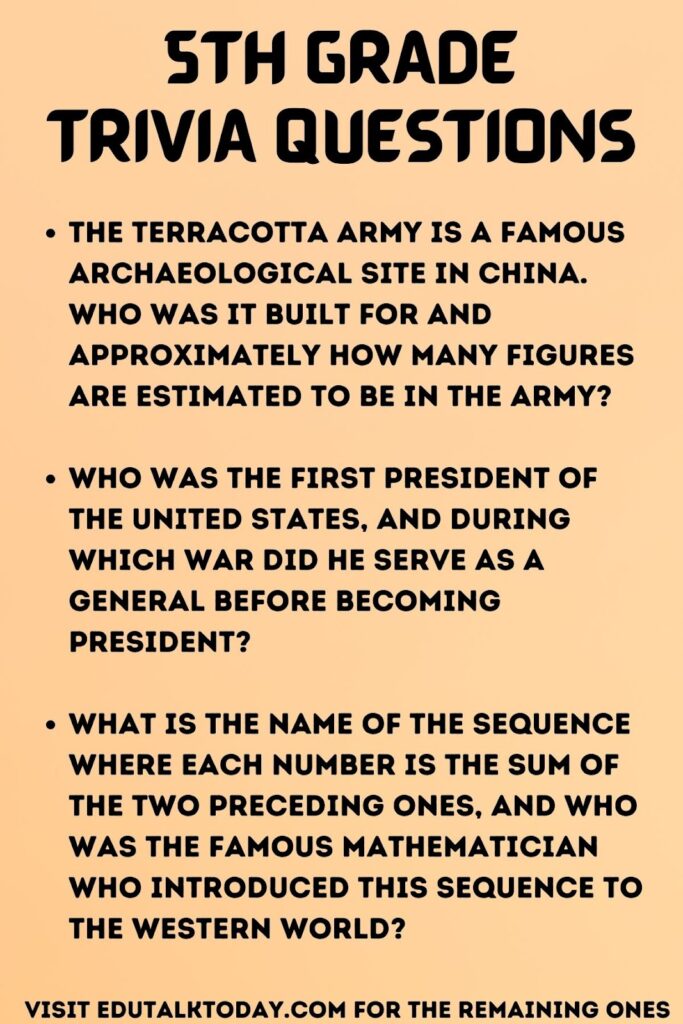36 5th Grade Trivia Questions

Trivia questions are a fantastic way to engage young learners and test their knowledge on a wide range of topics.
In this blog post, we’ve put together a list of trivia questions suitable for 5th graders. These questions cover various subjects, from science and history to pop culture and general knowledge.
Whether you’re a teacher looking for classroom activities or a parent wanting to challenge your child’s mind, these trivia questions are sure to be both fun and educational.
Let’s begin.
5th Graders Trivia Questions
- The Solar System Explorer: In our solar system, which planet is known for its beautiful rings, and is also the second-largest planet? Additionally, can you name at least two of its moons?
- The Deep Blue Mystery: Covering about 71% of the Earth’s surface, which is the largest ocean on our planet? Also, what unique, deepest point located in this ocean has been explored by humans?
- The Pharaoh’s Secrets: In ancient Egypt, the pyramids were built as monumental tombs. Which pyramid is the largest in Egypt and what was the name of the pharaoh for whom it was built?
- The Language Link: English borrows words from many languages. From which language does English get the words ‘ballet’, ‘café’, and ‘rendezvous’, and what is the capital city of this country?
- Journey through the Human Body: What is the largest organ inside the human body, and how does it help in digesting food?
- The Dinosaur Age: Dinosaurs roamed the Earth millions of years ago. Can you name the period that lasted from about 252 to 66 million years ago, during which dinosaurs were dominant?
- The Artistic Genius: Leonardo da Vinci was a famous artist and inventor. Name one of his most famous paintings, and mention one of his famous inventions or scientific contributions.
- Exploring Outer Space: What is the name of the first artificial satellite launched into space, which country launched it, and in what year did this historic event take place?
- The Animal Kingdom’s Record Holders: Which land animal is known to be the fastest, reaching speeds up to 60-70 miles per hour, and in which continent is this animal predominantly found?
- The Amazon Adventure: The Amazon Rainforest is one of the largest and most diverse ecosystems on Earth. In which South American country is the majority of this rainforest located, and can you name two unique animals that live there?
- The Frozen Continent: Which continent is known as the coldest, driest, and windiest, and is almost entirely covered by ice? Also, name one of the research stations established there by scientists.
- Inventors and Inventions: Who invented the light bulb, and in what year was it patented? Also, mention one other significant invention by the same person.
- World Cultures and Festivals: The festival of Diwali is celebrated with great enthusiasm in India. What is this festival also known as, and what is the main reason behind its celebration?
- The Wonders of the World: The Great Wall of China is one of the most famous structures in the world. Approximately how long is it, and during which dynasty was most of it built?
- Famous Explorers: Who was the first person to reach the South Pole, in what year did this happen, and what nationality was this explorer?
- The Depths of the Ocean: What is the name of the world’s largest coral reef system, where is it located, and why is it significant to marine life?
- The Stars and Beyond: What is the name of the closest star to Earth after the Sun, and how far is it approximately from Earth in light-years?
- Historical Landmarks: The Statue of Liberty was a gift to the United States from which country, and in what year was it dedicated? Also, what does this statue symbolize?
- Mysteries of Ancient Civilizations: In which ancient civilization were hieroglyphics used as a form of writing, and on what type of material was the Rosetta Stone, which helped decode these hieroglyphics, made?
- The Universe’s Wonders: What is the largest planet in our solar system, and can you name its most famous storm that is large enough to engulf Earth?
- Environmental Science: What is the process by which plants make their food using sunlight called, and what are the two main products of this process?
- Mathematical Marvels: What is the name of the sequence where each number is the sum of the two preceding ones, and who was the famous mathematician who introduced this sequence to the Western world?
- Exploring Continents: Which is the largest continent in the world by area, and can you name two countries that are part of this continent?
- Ancient Architecture: In ancient Rome, what was the Colosseum used for, and approximately how many spectators could it hold?
- Animal Kingdom: What is the largest mammal in the world, and in which oceans can it commonly be found?
- Famous Landmarks: Where is the Eiffel Tower located, for what event was it originally constructed, and in what year was it opened to the public?
- Historical Figures: Who was the first President of the United States, and during which war did he serve as a general before becoming president?
- Astronomical Phenomena: What is a solar eclipse, and what must happen for a solar eclipse to be observed from Earth?
- Historical Artifacts: The Terracotta Army is a famous archaeological site in China. Who was it built for and approximately how many figures are estimated to be in the army?
- Global Geography: Mount Everest is the highest mountain in the world. On the border of which two countries is it located, and approximately how high is it?
- Scientific Discoveries: Who is credited with the theory of relativity, and what is the famous equation associated with this theory?
- Cultural Celebrations: What is the significance of the Japanese festival ‘Hanami’, and what do people traditionally do during this festival?
- Animal Adaptations: What is camouflage, and can you name an animal that uses camouflage effectively in its natural habitat?
- World Literature: Who wrote the epic poem ‘The Odyssey’, and what is the name of its main character, who struggles to return home after the Trojan War?
- The Human Body: What is the name of the largest bone in the human body, and where is it located?
- Inventive Milestones: What was the name of the first successful airplane, who invented it, and in what year did its first flight take place?
Answers
- The Solar System Explorer: The planet with beautiful rings is Saturn, and it is the second-largest planet in our solar system. Two of its moons are Titan and Enceladus.
- The Deep Blue Mystery: The Pacific Ocean is the largest ocean on Earth. The Mariana Trench, which includes the Challenger Deep, is its deepest point and has been explored by humans.
- The Pharaoh’s Secrets: The largest pyramid in Egypt is the Great Pyramid of Giza. It was built for Pharaoh Khufu (also known as Cheops).
- The Language Link: These words are borrowed from French, and the capital city of France is Paris.
- Journey through the Human Body: The largest organ inside the human body is the liver. It helps in digestion by producing bile, which breaks down fats into fatty acids.
- The Dinosaur Age: This period is known as the Mesozoic Era.
- The Artistic Genius: One of Leonardo da Vinci’s most famous paintings is the ‘Mona Lisa’. Among his many inventions and scientific contributions is the concept of the parachute.
- Exploring Outer Space: The first artificial satellite was Sputnik 1, launched by the Soviet Union in 1957.
- The Animal Kingdom’s Record Holders: The Cheetah is the fastest land animal, capable of reaching speeds of 60-70 mph. It is predominantly found in Africa.
- The Amazon Adventure: The majority of the Amazon Rainforest is located in Brazil. Unique animals that live there include the jaguar and the Amazon river dolphin.
- The Frozen Continent: Antarctica is the coldest, driest, and windiest continent. One of the research stations there is McMurdo Station.
- Inventors and Inventions: Thomas Edison invented the light bulb, patented in 1879. Another significant invention by Edison is the phonograph.
- World Cultures and Festivals: Diwali is also known as the “Festival of Lights.” It is mainly celebrated to mark the victory of light over darkness and good over evil.
- The Wonders of the World: The Great Wall of China is approximately 13,170 miles long. Most of it was built during the Ming Dynasty.
- Famous Explorers: Roald Amundsen was the first person to reach the South Pole, achieving this feat in 1911. He was Norwegian.
- The Depths of the Ocean: The Great Barrier Reef is the world’s largest coral reef system, located off the coast of Queensland, Australia. It is significant for its diverse marine life and is a World Heritage Site.
- The Stars and Beyond: The closest star to Earth after the Sun is Proxima Centauri. It is approximately 4.24 light-years away from Earth.
- Historical Landmarks: The Statue of Liberty was a gift from France, dedicated in 1886. It symbolizes freedom and democracy.
- Mysteries of Ancient Civilizations: Hieroglyphics were used in ancient Egypt. The Rosetta Stone, crucial in deciphering these hieroglyphics, was made of granodiorite.
- The Universe’s Wonders: The largest planet in our solar system is Jupiter. Its most famous storm is the Great Red Spot, which is larger than Earth.
- Environmental Science: The process is called photosynthesis. The two main products of this process are oxygen and glucose (a type of sugar).
- Mathematical Marvels: This is known as the Fibonacci sequence. The sequence was introduced to the Western world by Leonardo of Pisa, also known as Fibonacci.
- Exploring Continents: Asia is the largest continent by area. Two countries in Asia are China and India.
- Ancient Architecture: The Colosseum in ancient Rome was used for gladiatorial contests and public spectacles. It could hold around 50,000 spectators.
- Animal Kingdom: The Blue Whale is the largest mammal in the world. It can be found in all the world’s oceans, from the Arctic to the Antarctic.
- Famous Landmarks: The Eiffel Tower is located in Paris, France. It was originally constructed for the 1889 World’s Fair (Exposition Universelle). It was opened to the public in the same year.
- Historical Figures: The first President of the United States was George Washington. He served as a general during the American Revolutionary War.
- Astronomical Phenomena: A solar eclipse occurs when the Moon passes between the Earth and the Sun, temporarily blocking the Sun’s light. For a solar eclipse to be observed from Earth, the Sun, Moon, and Earth must be precisely aligned.
- Historical Artifacts: The Terracotta Army was built for the first Emperor of China, Qin Shi Huang. It’s estimated to consist of over 8,000 soldiers, 130 chariots, and 670 horses.
- Global Geography: Mount Everest is located on the border between Nepal and the Tibet Autonomous Region of China. Its height is approximately 29,029 feet (8,848 meters).
- Scientific Discoveries: Albert Einstein is credited with the theory of relativity. The famous equation associated with this theory is E=mc².
- Cultural Celebrations: ‘Hanami’ is the Japanese tradition of appreciating the beauty of cherry blossoms. During the festival, people gather under cherry blossom trees to enjoy the scenery and often have picnics.
- Animal Adaptations: Camouflage is a method of hiding by blending in with the environment. The chameleon is an animal well-known for using camouflage, changing its skin color to match its surroundings.
- World Literature: ‘The Odyssey’ was written by the ancient Greek poet Homer. Its main character is Odysseus, who faces numerous challenges on his journey home after the Trojan War.
- The Human Body: The femur is the largest bone in the human body, located in the thigh.
- Inventive Milestones: The first successful airplane was named the Wright Flyer, invented by Orville and Wilbur Wright. Its first flight took place on December 17, 1903.






